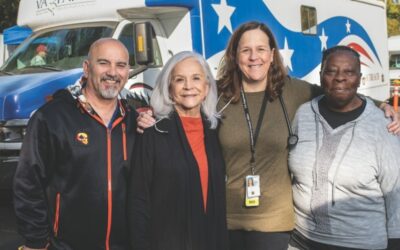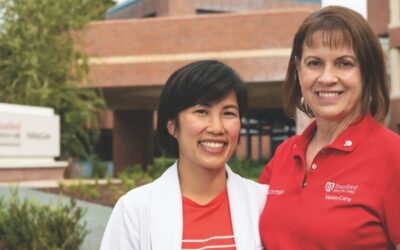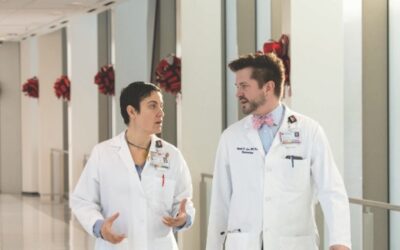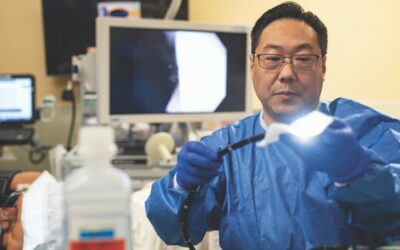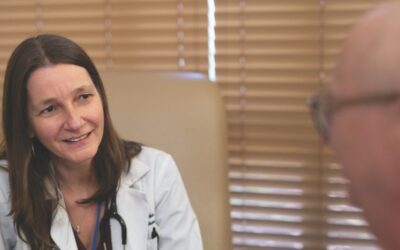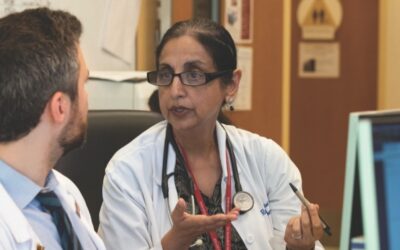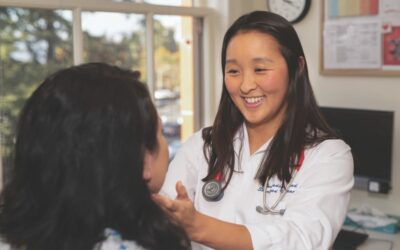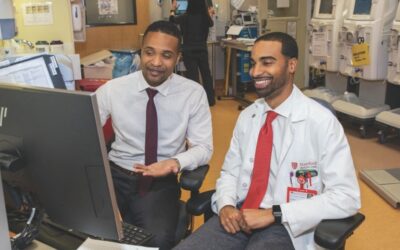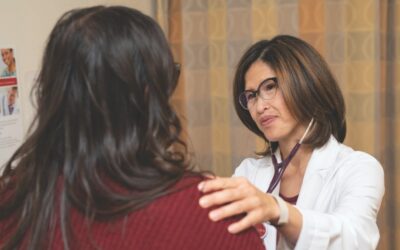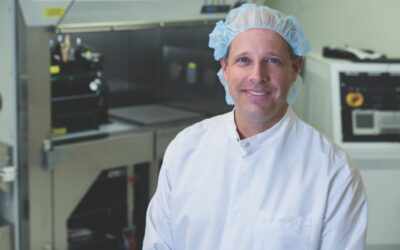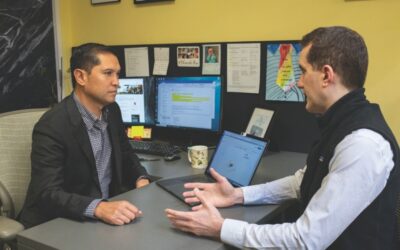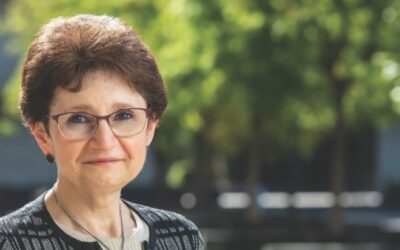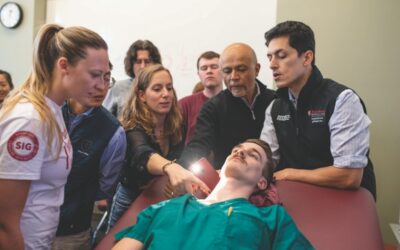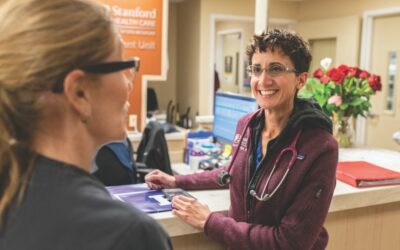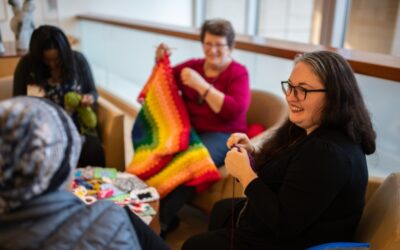
Department of Medicine 2020 Annual Report
Our Broad Reach
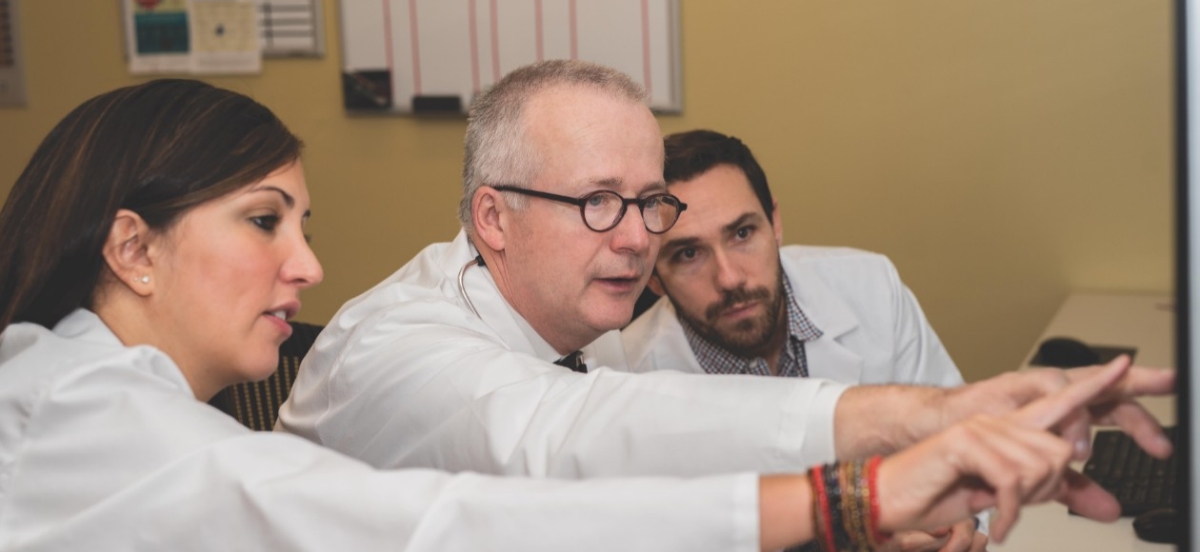
Over the course of an academic year we have many opportunities to learn what our colleagues are accomplishing: rounds at the division or department level, news items on department and division websites, award ceremonies, and our annual state of the department conference, among others. Once a year, we publish our annual report, which contains articles about the clinical, educational, research, and outside activities of individuals and groups throughout the department.
Every annual report has a theme. This year’s report focuses on how we’re extending our reach, whether through recent advances in treating a variety of diseases, or different approaches to the practice of medicine, or the diverse faces of medicine at Stanford. In these pages any one of us might find a nugget of information that could move our own research forward after a conversation with the colleagues an article describes.
Each individual article is like a pebble tossed in the water, its ripples widening over time to an unknowable extent, not unlike a lab discovery that turns into a drug development project and thereafter becomes a therapy that is successful in clinical trials until ultimately it becomes a treatment that heals patients worldwide.
Here are a few examples of how we’re making an impact beyond our department: Our colleagues are transforming care for patients with sarcoidosis by treating them within a hub of all the subspecialists involved in their care so they can see everyone they need to see on a single day. Several faculty members are applying artificial intelligence to underpin new approaches to caring for patients with pulmonary and other diseases. You can learn about the work that nocturnists do when they assume the overnight care of patients in our recently-opened hospital. With an emphasis on diversity, we are making it possible for sexual and gender minority populations here and elsewhere to receive better treatment through the creation of a database by The PRIDE Study. For women in medicine there is a new seminar series tailored for them with space devoted to connect and to share wisdom.
These and the other articles in this annual report are but a snapshot of the larger picture of what we in the Department of Medicine do every day. I hope you will spend some time here learning about the work of our colleagues and take pride in the accomplishments we all achieve through a variety of amazing talents and activities.
Sincerely,
Robert Harrington, MD
Chair, Department of Medicine
Extending our Reach in Diverse Ways
Diverse Faces of Medicine
Taking PRIDE in Their Work
Taking Veteran Care on the Road
The Power of Connection
A Helping Hand
Practitioner Liability
A Patient’s Last Wish
Recent Advances in Treatment
Leading the Way in Esophageal Diseases
Immunotherapy Gives Hope to Multiple Myeloma Patients
Novel Cancer Treatment Shows Promise
Making a Place for Cancer Survivors
The Down-to-Earth Goals of Two Nephrology Fellows
Immunology and Rheumatology
CREDENCE Brings Together Multiple Groups
New Approaches to Tobacco Control
Regulatory T Cells Join the Mainstream
Different Approaches to Medical Practice
Diagnosing Lung Disease with Help from Computers
The Medical Promise of Artificial Intelligence
Marina Basina’s Masterful Teaching and Patient Care
The Enormous Reach of the Stanford Medicine 25
Why Aren’t There More Female Cardiologists?
All in a Night’s Work
Off Hours
Department of Medicine in Numbers
15 Divisions
32 Endowed Professors
495 Trainees
(137 Residents, 154 MD Fellows, 204 Post-docs)
375 Active Grants—End of FY19
(4 Program Projects, 74 R-01s, 30 Ks, 22 Us, 10 Training, 41 Federal Awards, 194 Non-Federal)
625 Faculty
(109 University Tenure and Nontenure Line, 117 Medical Center Line, 359 Clinician Educators, 40 Instructors)
813 Staff and Research Associates
(570 Staff, 97 Research Associates, 146 Contingent Staff)
$135M Sponsored Research—FY19
($79 million in federal grants, $33 million in non-federal grants, $23 million in clinical grants)
Diverse Faces of Medicine
Taking Veteran Care on the Road
From left: Danny Molina, Doral Gonzales, Jean Lighthall, MD, and Anna Coulter.From left: Danny Molina, Doral Gonzales, Jean Lighthall, MD, and Anna Coulter.THE WOMEN IN MEDICINE GROUP IS CREATING COMMUNITY AND AMPLIFYING RESIDENTS’ VOICES. They...
A Patient’s Last Wish
Minh-Chi Tran, MD (left) and Betts Cravotto are granting wishes to bring comfort to the dying.Minh-Chi Tran, MD (left) and Betts Cravotto are granting wishes to bring comfort to the dying.A BOWL OF ICE CREAM. A MARIACHI BAND. A WORD CLOUD. When...
Taking PRIDE in Their Work
Juno Obedin-Maliver, MD, MPH, MAS (left), and Mitchell R. Lunn, MD, MAS, want to understand how identifying as a sexual and gender minority person affects one’s health—physically, mentally, and socially.Juno Obedin-Maliver, MD, MPH, MAS (left),...
Practitioner Liability
"Whatever lies behind these shifts, it is problematic. From a patient safety standpoint, this is the study’s most troubling finding." — David Studdert, LLB, ScD, MPH"Whatever lies behind these shifts, it is problematic. From a patient safety...
The Power of Connection
Residents stretch during a Women in Medicine-sponsored yoga classResidents stretch during a Women in Medicine-sponsored yoga classTHE WOMEN IN MEDICINE GROUP IS CREATING COMMUNITY AND AMPLIFYING RESIDENTS’ VOICES. In 2010, Cybele Renault, MD, a...
A Helping Hand
From left: Baldeep Singh, MD, Jonathan Glazer Shaw, MD, MS, and Kirsti Weng, MD, MPH.From left: Baldeep Singh, MD, Jonathan Glazer Shaw, MD, MS, and Kirsti Weng, MD, MPH.NEW INITIATIVES ARE SUPPORTING VULNERABLE POPULATIONS IN NEARBY COMMUNITIES. A...
Recent Advances in Treatment
Leading the Way in Esophageal Diseases
Joo Ha Hwang, MD, PhD, uses the endoscope to treat cancers and other gastrointestinal diseases.Joo Ha Hwang, MD, PhD, uses the endoscope to treat cancers and other gastrointestinal diseases.GASTROENTEROLOGIST JOO HA HWANG IS ONE OF JUST A FEW...
Immunotherapy Gives Hope to Multiple Myeloma Patients
Michaela Liedtke, MDMichaela Liedtke, MDFor most of us, a common cold or a stomach bug is a nuisance, but usually in a matter of days the body’s immune system will fight off the invading disease-causing agents and we’ll get back to normal. In more...
Novel Cancer Treatment Shows Promise
Ranjana Advani, MDRanjana Advani, MDA novel immunotherapy combination appears safe for use in patients with a type of blood cancer called non-Hodgkin’s lymphoma. Not only that, but half of the 22 people enrolled in an early clinical trial of the...
Making a Place for Cancer Survivors
Jennifer Kim, MD, is helping bridge the gap between oncology and primary care.Jennifer Kim, MD, is helping bridge the gap between oncology and primary care.PRIMARY CARE PHYSICIAN JENNIFER KIM IS HELPING PATIENTS BRIDGE THE GAP BETWEEN CANCER...
The Down-to-Earth Goals of Two Nephrology Fellows
From left: Nephrology fellows Dimitri Augustin, MD, MS, and Daniel Watford, MD, MPH, look over data from a patient with kidney disease.From left: Nephrology fellows Dimitri Augustin, MD, MS, and Daniel Watford, MD, MPH, look over data from a...
Immunology and Rheumatology Faculty Reach Across Divisions to Fight Disease
Sarcoidosis is a rare disease that can manifest in various ways.Sarcoidosis is a rare disease that can manifest in various ways.In many ways, modern medicine is getting more intimate in scope: Think targeted cell-based therapies or interventions...
CREDENCE Brings Together Multiple Groups in Successful Trial
Sun Kim, MD, MS, a principal investigator for CREDENCE, examines a patient with Type 2 diabetes.Sun Kim, MD, MS, a principal investigator for CREDENCE, examines a patient with Type 2 diabetes.Sun Kim, MD, MS, associate professor of endocrinology,...
New Approaches to Tobacco Control
Jodi Prochaska, PhD, MPHJodi Prochaska, PhD, MPHThe tobacco products of today are not just your grandfather’s unfiltered Lucky Strikes or Camels, but rather natural and organic cigarettes, confectionary-flavored e-cigarettes and vapes, and emerging...
Regulatory T Cells Join the Mainstream
Everett Meyer, MD, PhD, leads a team that replaces immunosuppressive agents with T regulatory cells for patients with specific cancers.Everett Meyer, MD, PhD, leads a team that replaces immunosuppressive agents with T regulatory cells for patients...
Different Approaches to Medical Practice
Diagnosing Lung Disease with Help from Computers
Joe Hsu, MD (left) and Husham Sharifi, MD, discuss diagnostic techniques using machine learning.Joe Hsu, MD (left) and Husham Sharifi, MD, discuss diagnostic techniques using machine learning.APPLYING MACHINE LEARNING ALGORITHMS TO PATIENT DATA IS...
The Medical Promise of Artificial Intelligence
Olivier Gevaert, PhDOlivier Gevaert, PhDNow that computers can be taught to process large amounts of data and to recognize patterns in them, their usefulness in medicine is greatly enhanced. In the hands of Olivier Gevaert, PhD, assistant professor...
Marina Basina’s Masterful Teaching and Patient Care
Marina Basina, MDMarina Basina, MDClinical associate professor of endocrinology Marina Basina, MD, has been caring for patients with Type 1 diabetes since she completed her fellowship and joined the Stanford faculty in 2003. She heads the inpatient...
The Enormous Reach of the Stanford Medicine 25
Errol Ozdalga, MD (far right), and Abraham Verghese, MD (holding iPhone), demonstrate one of the Stanford 25 physical diagnosis skills to a group of attentive residents.Errol Ozdalga, MD (far right), and Abraham Verghese, MD (holding iPhone),...
Why Aren’t There More Female Cardiologists?
Bongeka Zuma (left), a medical student interested in cardiology, meeting with Fatima Rodriguez, MD, MPH.Bongeka Zuma (left), a medical student interested in cardiology, meeting with Fatima Rodriguez, MD, MPH.We know that slightly more than half of...
All in a Night’s Work
Nocturnist Rita Pandya, MD, cares for hospital patients overnight.Nocturnist Rita Pandya, MD, cares for hospital patients overnight.WHEN DOCTORS LEAVE THE HOSPITAL FOR THE DAY, ANOTHER TEAM OF DOCTORS—NOCTURNISTS—STEP IN. They begin their shifts...
Off Hours
In their off hours, Stanford staff have a variety of exciting hobbies.In their off hours, Stanford staff have a variety of exciting hobbies.EACH TUESDAY AT NOON, HEIDI ELMORE MAKES HER WAY ACROSS CAMPUS TO STANFORD HOSPITAL, WHERE SHE SPENDS THE...
“They’re leaving a legacy—they want things to be better for the women who come after them.”
— Cybele Renault, MD
“I like taking a single thread, combining it with other things, and making an entirely different product. That is also a lot like life—whether you’re at work or at home. We take all the little pieces and stitch them together to make something new and wonderful.”
— Heidi Elmore
“You can imagine that if you treat each data source in isolation, you will have some predictive value. But what happens if we put them together?”
— Olivier Gevaert, PhD
“If we can show that people who have had many traumatic experiences on the basis of their gender identity or sexual orientation have certain health outcomes, then that can provide some evidence to actually change policy and laws.”
— Mitchell R. Lunn, MD, MAS
“It means we really detected a hidden system for classifying patients that is highly relevant to underlying disease biology and clinical outcomes.”
— Andrew Sweatt, MD
“We’re bringing in leaders in gastric cancer from all over the world to talk about how we can establish screening guidelines for high-risk populations.”
— Joo Ha Hwang, MD, PhD

